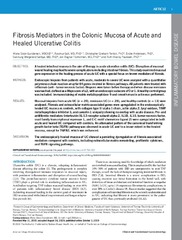Fibrosis Mediators in the Colonic Mucosa of Acute and Healed Ulcerative Colitis
Permanent link
https://hdl.handle.net/10037/16620Date
2019-10-03Type
Journal articleTidsskriftartikkel
Peer reviewed
Author
Gundersen, Mona Dixon; Goll, Rasmus; Fenton, Christopher Graham; Anderssen, Endre; Sørbye, Sveinung Wergeland; Florholmen, Jon; Paulssen, Ruth HAbstract
METHODS: Endoscopic biopsies from patients with acute, moderate to severe UC were analyzed with a quantitative polymerase chain reaction array for 84 genes involved in fibrosis pathways. All patients were treated with infliximab (anti– tumor necrosis factor). Biopsies were taken before therapy and when disease remission was reached, defined as a Mayo score of£2, with an endoscopic subscore of 0 or 1. A healthy control group was included. Immunostaining of matrix metallopeptidase 9 and smooth muscle actin was performed.
RESULTS: Mucosal biopsies from acute UC (n 5 28), remission UC (n 5 28), and healthy controls (n 5 13) were analyzed. Fibrosis and extracellular matrix-associated genes were upregulated in the endoscopically healed UC mucosa vs controls, with collagen type III alpha 1 chain, actin alpha 2, lysyl oxidase, TIMP metallopeptidase inhibitor 3, and caveolin 1 uniquely showing no overlap with acute disease. Pro- and antifibrotic mediators (interleukin [IL]13 receptor subunit alpha 2, IL1B, IL10, tumor necrosis factor, snail family transcriptional repressor 1, and C-C motif chemokine ligand 2) were upregulated in both acute and healed UC compared with controls. An attenuated pattern of the canonical transforming growth factor beta (TGFB) pathway was observed in acute UC and to a lesser extent in the healed mucosa, except for TGFB2, which was enhanced.
DISCUSSION: The endoscopically healed mucosa of UC showed a persisting dysregulation of fibrosis-associated mediators compared with controls, including extracellular matrix remodeling, profibrotic cytokines, and TGFB signaling pathways.


 English
English norsk
norsk